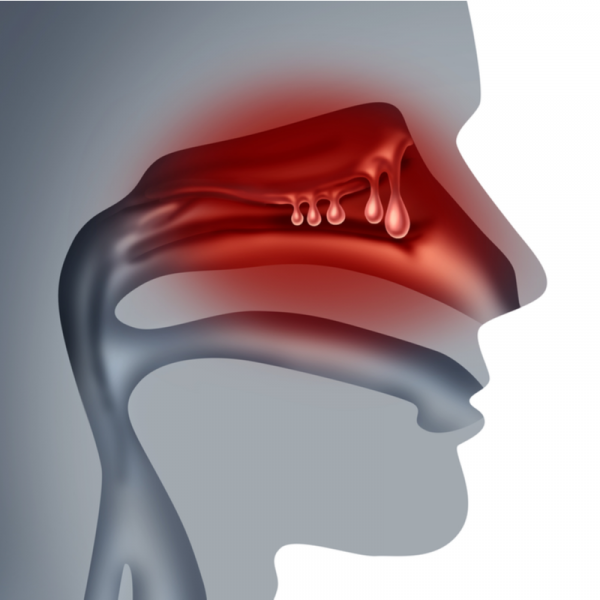
What is a nasal polyp?
A nasal polyp is a benign growth of tissue in the sinuses that consists of soft, oedematous connective tissue. Nasal polyps usually always occur on both sides and take on a greyish-pink or glassy honey-coloured appearance. They either grow in drops, sit on top of the nasal mucosa or emerge from the mucosa like a stalk. Nasal polyps can take on different dimensions. Small nasal polyps are only a few millimetres in size, while larger nasal polyps can cover several centimetres and completely block the nasal cavity. Men in particular suffer more from nasal polyps after the age of 30.
Where and how do nasal polyps develop?
Starting from the paranasal sinuses, the nasal polyp grows into the main nasal cavity. Polyps often form in the ethmoid sinuses and the sphenoid sinus. In rather rare cases, nasal polyps can also settle in the ostiomeatal complex (region in the middle nasal passage).
Nasal polyps often develop due to genetic factors that make the mucous membrane more susceptible to chronic inflammation of the sinuses (chronic sinusitis) or the nasal mucosa, for example. But allergy sufferers, asthmatics or people who suffer from painkiller intolerance also develop nasal polyps more frequently. But children who suffer from the metabolic disease cystic fibrosis also often develop nasal polyps.
What are the symptoms of nasal polyps?
Nasal polyps can cause different symptoms depending on their size. Obstructed nasal breathing can lead to the person preferring to breathe through the mouth, which allows pathogens to enter the respiratory tract. This in turn can lead to inflammation or irritation of the larynx (laryngitis), throat (pharyngitis) or bronchi (bronchitis). In addition, nasal polyps can obstruct the task of the nose, such as humidifying, cleaning and warming the air we breathe.
How is a nasal polyp diagnosed?
If a nasal polyp is suspected, the ear, nose and throat (ENT) specialist will examine the nose and sinuses. Larger, but also smaller nasal polyps can usually be made visible by inspecting the nasal cavity through a light source (nasal endoscopy). However, other imaging procedures can also be performed, such as a computer tomography (CT) or a digital volume tomography (DVT).
How is a nasal polyp treated?
Since nasal polyps usually develop due to a chronic sinusitis, the ENT doctor will first treat this disease specifically. In addition, drugs such as glucocorticoids can be prescribed for nasal polyps, which are supposed to imitate the body's own hormone cortisol. Glucocorticoids are supposed to help inhibit the growth of small nasal polyps and can be administered in the form of a nasal spray, for example.
If, on the other hand, the nasal polyps are large, surgery can be performed. While smaller polyps can be removed on an outpatient basis by means of a polypectomy, large nasal polyps are usually removed under general anaesthesia. In many patients, the polyps recur at regular intervals even after successful treatment. In these cases, special medications can also be administered, such as biologicals (antibodies), which are designed to interfere with the inflammatory process that contributes to the development of the nasal polyps.
Polyps general settings
| Polyps growths | XTRA | Members get access to the frequencies immediately after registration. Register here! |
| Polyps General | EDTFL | Members get access to the frequencies immediately after registration. Sign up here! |
| Polyps General | CAFL | Members get access to the frequencies immediately after registration. Sign up here! |
| Polyps General | CAFL | Members get access to the frequencies immediately after registration. Sign up here! |
| Polyps General | CAFL | Members get access to the frequencies immediately after registration. Sign up here! |
Polyps specific settings
| Nasal Polyp | VEGA | Members get access to the frequencies immediately after registration. Sign up here! |
| Nasal polyp | CAFL | Members get access to the frequencies immediately after registration. Register here! |
